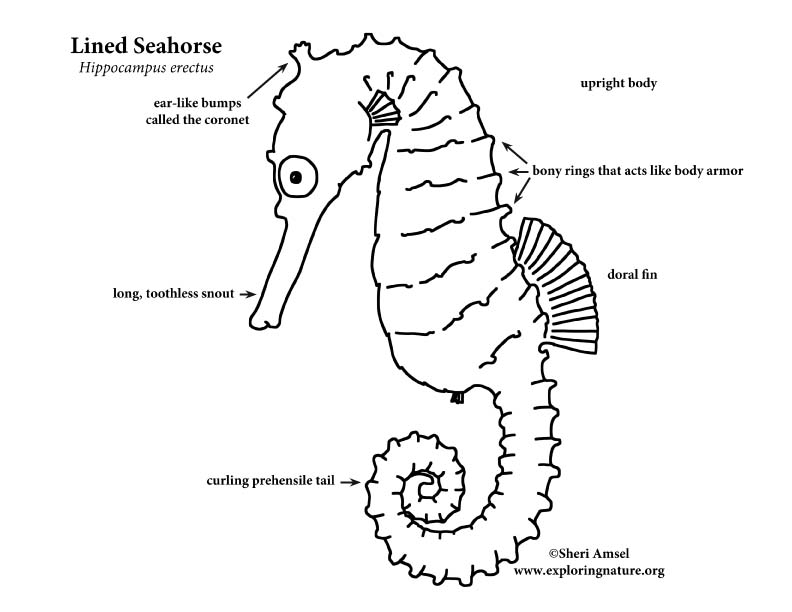

They are found along the Atlantic coast from New England to South America, along the Gulf Coast and around the Caribbean.
They can be found in coastal waters to depths of more than 200 feet. They are often found clinging to coral, sponges, mangrove roots, seagrass. Sadly, they also will cling to the growing abundance of ocean litter. In the winter they stay in deeper water.
Their head shape resembles a horse’s, with a long snout and ear-like bumps (coronet) on the top. They have an upright body with a curling prehensile tail (can wrap around and grip objects). Males have a longer tail and brood pouch on the belly. The body is covered in a skin that stretches over bony rings that acts like body armor (no scales). They They can reach 7 inches tall. They have a long, toothless snout. They vary in color from yellow, orange, red to brown. They have white lines that on the body and spots on the back and tail.
Their head shape resembles a horse’s, with a long snout and ear-like bumps (cornonet) on the top. They have an upright body with a curling prehensile tail (can wrap around and grip objects). Males have a longer tail and brood pouch on the belly. The body is covered in a skin that stretches over bony rings that acts like body armor (no scales). They They can reach 7 inches tall. They have a long, toothless snout. They vary in color from yellow, orange, red to brown. They have white lines that on the body and spots on the back and tail.
They eat small sea creatures that they can suck into their snout and swallow whole. This includes small fish, plankton, shrimp and plant bits.
After performing complex courtship displays, seahorse pairs will bond for life (which is often just one season). The female will deliver hundreds of tiny eggs in to the male’s inflated brood pouch. The male will then seal the pouch, fertilize the eggs and carry the developing young until they hatch (about 3 weeks) and are able to swim on their own. Then the young are ejected from the pouch and swim away.
Kingdom: Animalia
Phylum: Chordata
Subphylum: Vertebrata
Class: Actinopterygii
Order: Syngnathiformes
Family: Syngnathidae
Genus: Hippocampus
Species: H. erectus
When you research information you must cite the reference. Citing for websites is different from citing from books, magazines and periodicals. The style of citing shown here is from the MLA Style Citations (Modern Language Association).
When citing a WEBSITE the general format is as follows.
Author Last Name, First Name(s). "Title: Subtitle of Part of Web Page, if appropriate." Title: Subtitle: Section of Page if appropriate. Sponsoring/Publishing Agency, If Given. Additional significant descriptive information. Date of Electronic Publication or other Date, such as Last Updated. Day Month Year of access < URL >.
Amsel, Sheri. "Seahorse (Lined)" Exploring Nature Educational Resource ©2005-2024. December 13, 2024
< http://www.exploringnature.org/db/view/seahorse >

